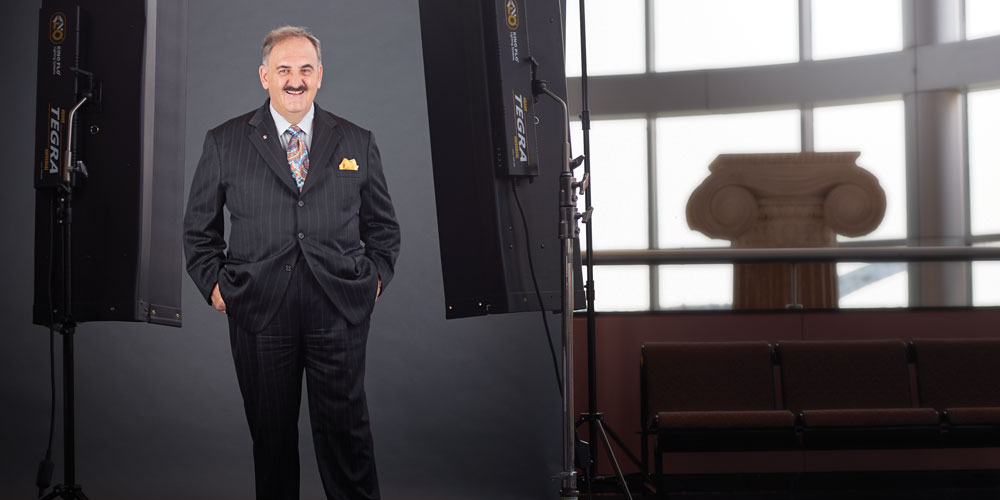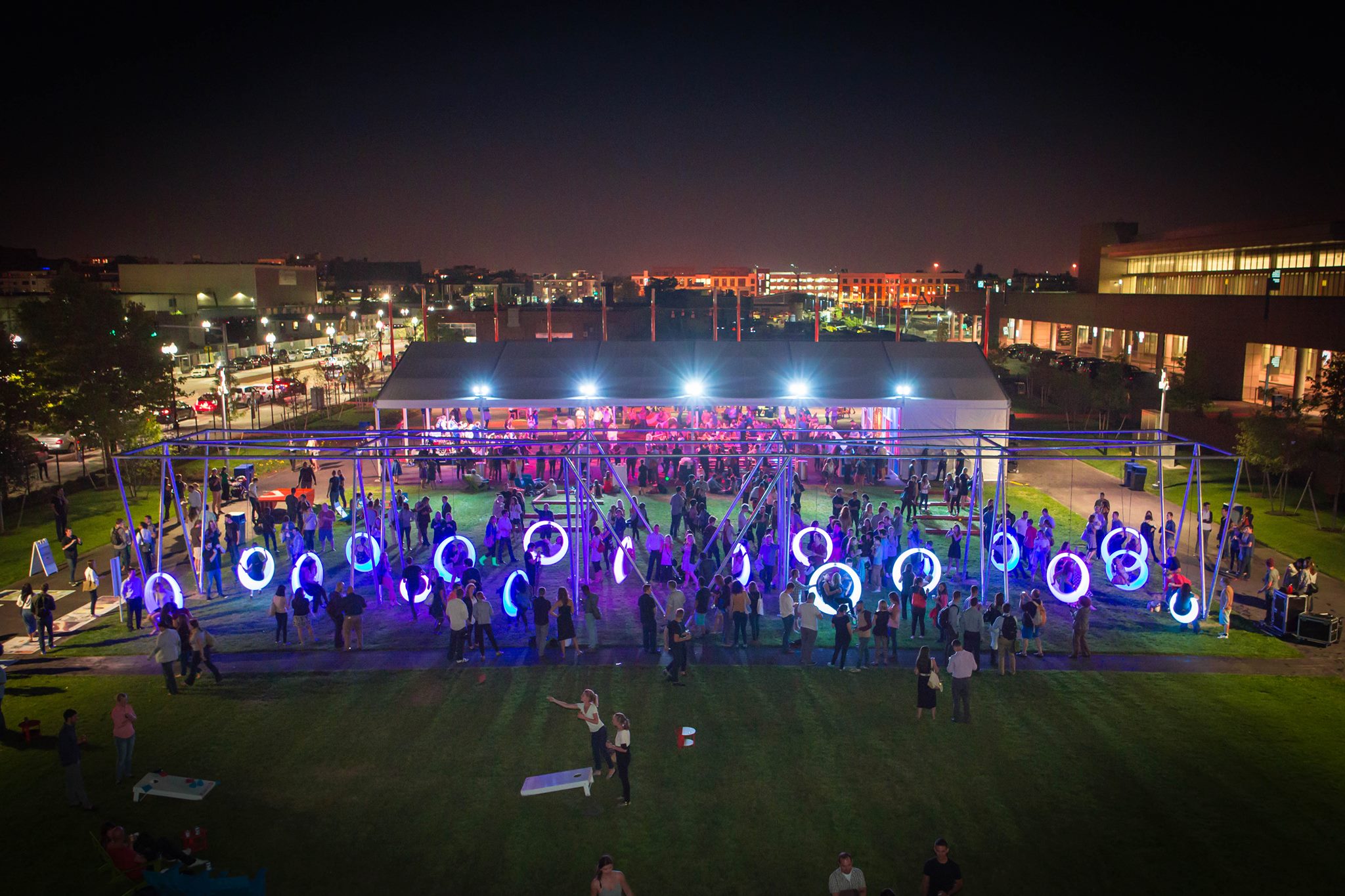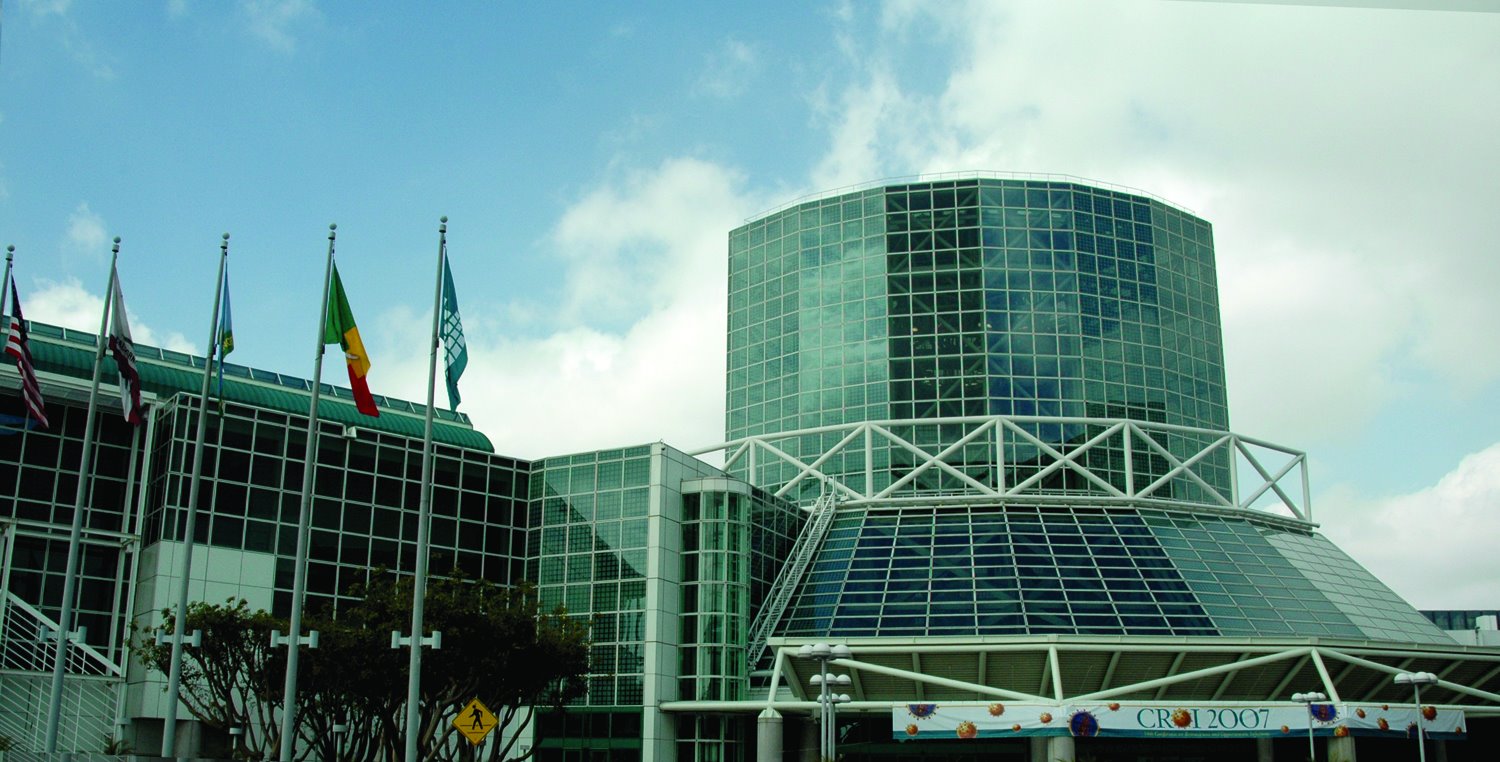Convention Centers and Outdoor Spaces
Researchers are increasingly discovering the negative effects of sitting too much and the positive results of getting outside. By taking a quick walk in nature, one can improve mental health and be more energized for education. Convention center designers and event attendees are noticing this research, too.
“Over the last few years, we’ve been hearing more and more from these people that conventioneers don’t want to be locked in,” Todd Voth, a senior principal at architecture firm Populous, recently told The New York Times. “I really think people that go to conventions are sick and tired of being stuck in a building all day.”
The Times article, “Fresh Air for Conventions,” addresses the increased interest in outdoor spaces attached to convention centers and some of the ways they’re being used.
For example, in an upcoming FM article, IAVM member James Rooney, executive director of the Massachusetts Convention Center Authority, writes about the new lawn space at the Boston Convention and Exhibition Center (BCEC).
“With expansion, we have plans to not just grow in size, but to grow smart, thinking about the future of the meetings industry by designing innovative events spaces,” Rooney wrote. “In fact, at the BCEC we recently launched ‘The Lawn on D,’ a first-of-its-kind experimental green event space. Open to the public and available for private events, the 2.7-acre green space not only serves as an important community initiative, but also as a engaging space where meeting planners can get creative and wow their attendees.”
Several IAVM members are quoted in the Times article: Thom Connors, regional vice president and general manager of the Cobo Center in Detroit, Michigan; Michael Sawaya, executive director of the convention and sports facilities department in San Antonio, Texas; Tim Muldoon, general manager at the David L. Lawrence Convention Center in Pittsburgh, Pennsylvania; Ken Stockdell, vice president at architecture firm HKS; and Charles H. Johnson, president of C.H. Johnson Consulting.
It’s a great article, and I recommend you read it, because outdoor spaces is a positive trend, both for one’s mental health as well as the wallet.
“There’s pressure for finding new revenue sources for these buildings,” Stockdell said. “That’s attractive to the convention center on the operational side of things because food and beverage is the No. 1 income generator after space rental.”
If you’re interested in more topics about convention centers, please plan to attend the 2014 International Convention Center Conference, October 2-4, in Vancouver, British Columbia, where attendees will learn the latest in revenue trends, industry forecasts, and best practices.
(Image: The Lawn on D Facebook page)
Joe Floreano, 1947-2014

It is with great sadness that we share with you that Joe Floreano, CFE, longtime IAVM member and executive director of the Rochester Riverside Convention Center in New York, has passed away due to cancer. He was 67.
“We lost an amazing person and friend,” said IAVM member Lional Dubay, assistant vice president and director of the business services division at the University of Florida. “He will be missed but always in our hearts. My thoughts and prayers go out to Joe’s family during this difficult time.”
Floreano began working at the convention center in 1983, and over the years, received numerous accolades from New York’s senate, assembly, and governor for his leadership skills and community involvement. He was a past IAVM chairman, a Charles A. McElravy Award honoree, and recipient of the 2014 Legacy Award for venue management excellence, awarded by the IAVM Foundation.
The City of Rochester will honor Floreano’s legacy by renaming the convention center as the Joseph A. Floreano Rochester Riverside Convention Center. The mayor, the Rochester Convention Center Management Corporation Board of Directors, and the Rochester City Council and members will gather for a special ceremony on Wednesday, September 24, for the naming, and the city is web casting it live at 2:15 p.m. (ET) at http://www.cityofrochester.gov/mayorwebcast.
“Joe’s many contributions will be with us forever, but this historic and tangible legacy of his leadership will remind everyone, on a daily basis, how much Joe did for the industry and his city he loved so much,” said IAVM member Steve Gregosky, senior vice president of business development for Ovations Food Services.
Floreano’s love for the venue industry was evident to all, and was recognized this past July during the IAVM Venue Industry Awards Luncheon at the VenueConnect Annual Conference & Trade Show in Portland, Oregon.
Jason Rittenberry, CFE, chair of the IAVM Foundation Board of Trustees, and Brad Mayne, CFE, president and CEO of MetLife Stadium, presented Floreano with the 2014 Legacy Award—a prestigious honor that recognized Floreano’s significant support and impact on the industry through his involvement with the IAVM Foundation.
Inseparable from Floreano’s role with the Foundation is the new Build An Amazing Future campaign that debuted during the ceremony. The new projects from the Foundation carry on Floreano’s passion for young professionals in the industry, and include a 30-Under-30 development program, as well as an unprecedented number of scholarships to each of the major conferences and schools hosted by IAVM.
The Foundation is pleased to announce that the Joe Floreano Scholarship fund is being established within the Build An Amazing Future project, serving as an enduring reminder of Floreano’s unwavering commitment to passing an amazing future down to future generations. More information about the Foundation campaign is available at iavm.org/AmazingFuture.
“I am so sorry for the loss of such a great friend and colleague,” said former IAVM President and CEO Dexter King. “Joe was the consummate gentleman, full of love and care for all. I don’t think he ever met a person where he didn’t express genuine interest. He has helped shape my own life through the witness of his own. I will always cherish his time on this earth. Rest in peace, Joe. We will carry on your legacy as best we can.”
(Image: Ira Morris)
Close Encounter of the Third Kind with Google Glass
I am keeping a log on the device within event services. My summary so far:
Captain’s Log No. 1
Previewed Google Glass promo website. LOTS of promises of everything the device can do with photos of very attractive people doing very active things.
We are advised to
Be Active
Explore Your World
Live Lighter
Upon closer inspection of the website sub-pages, it looks like the tools are the same as other mobile devices (smartphone, tablets—Droid or iPhone), just on your head, viewed through a 3/8” x 3/8” x 3/4” clear cube, which is attached to either a head set or faux glasses. One can use vocal commands, get maps and directions, take photos or videos, play music, retrieve data, read a New York Times article, etc.
Later that day: Met with event services staff to discuss options. Ideas included:
• Display captioning / translations / supertitles?
• Record hands-on use of ticket scanners, reading a ticket, other procedures for training
• Can it read and transmit to another location, i.e. for a medical or trip and fall emergency?
Charged device before use.
Attempted setup for a user; got derailed after attempted “pairing” Google Glass with smartphone. IMPORTANT: Glass MUST have a host device.
Captain’s Log No. 2
Completed setup with device paired to Joe Durr cell phone; needed to register to a Google Gmail account. Had to download Glass App to phone.
Looks like Google Glass device is a transmitter; that is, it MUST have the smartphone or other mobile device in close proximity.
Question / observation: would each user of Glass need to have a paired device and OWN Gmail account? Or a “company” Gmail account? Can only ONE mobile device be registered to the Glass? TBD.
Set up instructions somewhat cumbersome, able to be peered through the “ice cube” (my term, not theirs), or display a larger image onto the paired cell phone screen on required downloaded Glass App. Confirms that Google Glass can/will transmit to another device.
Side of the Google Glass transmitter gets VERY warm, hot to the touch. It’s near my right temple! Having to look up and to the right for every wee visual nugget takes some getting used to. I’m not yet. And my contact lense gets stuck in an awkward position; makes reading difficult.
More to follow. Stay tuned.
Captain out.
(photo credit: Thomas Hawk via photopin cc)
Fairgrounds Help Bring Communities Together
The State Fair of Texas starts September 26, and I’ve been dreaming of fried food since this year’s Big Tex Choice Awards were announced. But that’s not what I’m writing about here; it’s just that talking about fairs makes me hungry for food, rides, and entertainment that pulls a community together.
“Fairs are unique social events that attract millions of people looking for affordable entertainment, education, food and to be a part of a large, community-oriented, cultural showcase,” wrote Bill Bourne, senior architect technician and senior associate at Populous. “We’ve seen a new business model emerge, where communities invest in fairgrounds as a year-round events complex and central community gathering space. There are a few reasons why fairgrounds & agricultural centers have attracted investment from local communities.”
Check out Bourne’s post on the Populous website to learn more about how fairs bring people together throughout the year and to learn more about the architectural firm’s recent renovations and plans for fairgrounds.
(Big Tex photo credit: ladybugbkt via photopin cc)
Los Angeles Convention Center Reaches Major Milestones
Congratulations are in order to the Los Angeles Convention Center (LACC), which has reached several financial and performance milestones since AEG Facilities took over the venue in December 2013.
According to final figures for a budget year that concluded on June 30, the LACC reported a $290,000 operational surplus. Other financial milestones the LACC is reporting include parking revenue increasing by $1 million, wages and salaries finishing $1.5 million lower than the previous year, increased usage and revenue from film and television production by 140 percent while new sustainability programs initiated in just the past six months have decreased electrical usage by 2 percent and decreased water usage by 10 percent year to year.
“Transitioning the Los Angeles Convention Center from a publicly operated entity to private management was a major undertaking, one that AEG Facilities implemented seamlessly,” said Bud Ovrom, executive director of the Los Angeles Department of Convention & Tourism Development. “We are very pleased with what AEG accomplished this first year, not only significantly improving the operational efficiencies and the bottom line, but also improving the customer service, security, and overall maintenance of our convention center. It took bold political leadership for this city to privatize management of one of our major public facilities, and we know now that selecting AEG Facilities as our partner to embark on this endeavor allowed us to successfully overcome the many challenges and set the LACC on a better course.”
 AEG also implemented the initial hiring and training of 82 full-time and 75 part-time employees in 2013, followed by an additional 25 more employees brought on in 2014.
AEG also implemented the initial hiring and training of 82 full-time and 75 part-time employees in 2013, followed by an additional 25 more employees brought on in 2014.
“We are extremely proud of the positive achievements already made at the Los Angeles Convention Center in such a short period of time”, said IAVM member Bob Newman, president of AEG Facilities. “The staff, with the full and unwavering support of the city, has created a true service culture that event planners are already recognizing as best in class in the industry.”
Other LACC accomplishments include hosting and event-managing a total of 167 events held over 298 event days from December 2013 through June 30, 2014; improving overall security and building coverage by increasing staffing numbers and conducting thorough training; and, with the assistance of AEG 1SOURCE, soliciting, negotiating, and completing more than 30 new contracts with service providers, contractors, and suppliers.
(Image via Los Angeles Convention Center Facebook page)
Do you want to receive a Front Row News weekly digest?
Categories
- Allied (861)
- Architecture (147)
- Arenas (747)
- Career (897)
- Convention Centers (895)
- Education (623)
- Events (1,544)
- Food & Beverage (193)
- Foundation (113)
- Guest Experience (1,496)
- Industry News (2,270)
- Leadership (1,888)
- Marketing (150)
- Membership (2,000)
- Music (213)
- Performing Arts Centers (454)
- Professional Development (409)
- Research (127)
- Safety & Security (442)
- Sports (763)
- Stadiums (608)
- Student (159)
- Technology (516)
- Ticketing (92)
- Touring (82)
- Trends (364)
- Uncategorized (743)
- Universities (218)
- Video (25)
- Young Professional (198)
Twitter Feed
- Twitter feed loading
Recent Posts
- Venuworks and ATG Entertainment Selected to Manage Fresno Convention and Entertainment Center
- Seattle Convention Center Announces Strategic Leadership Appointment and Growth Initiatives for 2026
- Peggy Daidakis Humbly Made Convention Center History
- Welcome to Our Newest Members
- New Member Benefit! IAVM Partners with Advantage Training to Elevate Staff Readiness and Guest Experience
Categories
- Allied
- Architecture
- Arenas
- Career
- Convention Centers
- Education
- Events
- Food & Beverage
- Foundation
- Guest Experience
- Industry News
- Leadership
- Marketing
- Membership
- Music
- Performing Arts Centers
- Professional Development
- Research
- Safety & Security
- Sports
- Stadiums
- Student
- Technology
- Ticketing
- Touring
- Trends
- Uncategorized
- Universities
- Video
- Young Professional
Archives
- December 2025
- November 2025
- October 2025
- September 2025
- August 2025
- July 2025
- June 2025
- May 2025
- April 2025
- March 2025
- February 2025
- January 2025
- December 2024
- November 2024
- October 2024
- September 2024
- August 2024
- July 2024
- June 2024
- May 2024
- April 2024
- March 2024
- February 2024
- January 2024
- December 2023
- November 2023
- October 2023
- September 2023
- August 2023
- July 2023
- June 2023
- May 2023
- April 2023
- March 2023
- February 2023
- January 2023
- December 2022
- November 2022
- October 2022
- September 2022
- August 2022
- July 2022
- June 2022
- May 2022
- April 2022
- March 2022
- February 2022
- January 2022
- December 2021
- November 2021
- October 2021
- September 2021
- August 2021
- July 2021
- June 2021
- May 2021
- April 2021
- March 2021
- February 2021
- January 2021
- December 2020
- November 2020
- October 2020
- September 2020
- August 2020
- July 2020
- June 2020
- May 2020
- April 2020
- March 2020
- February 2020
- January 2020
- December 2019
- November 2019
- October 2019
- September 2019
- August 2019
- July 2019
- June 2019
- May 2019
- April 2019
- March 2019
- February 2019
- January 2019
- December 2018
- November 2018
- October 2018
- September 2018
- August 2018
- July 2018
- June 2018
- May 2018
- April 2018
- March 2018
- February 2018
- January 2018
- December 2017
- November 2017
- October 2017
- September 2017
- August 2017
- July 2017
- June 2017
- May 2017
- April 2017
- March 2017
- February 2017
- January 2017
- December 2016
- November 2016
- October 2016
- September 2016
- August 2016
- July 2016
- June 2016
- May 2016
- April 2016
- March 2016
- February 2016
- January 2016
- December 2015
- November 2015
- October 2015
- September 2015
- August 2015
- July 2015
- June 2015
- May 2015
- April 2015
- March 2015
- February 2015
- January 2015
- December 2014
- November 2014
- October 2014
- September 2014
- August 2014
- July 2014
- June 2014
- May 2014
- April 2014
- March 2014
- February 2014
- January 2014
- December 2013
- November 2013
- October 2013
- September 2013
- August 2013
- July 2013
- June 2013
- May 2013
- April 2013
- March 2013
- February 2013
- January 2013
- May 2012
- March 2012
- December 2011
- November 2011
- October 2011
Recent Comments
- Frank Bradshaw, Ph.D., CVE on John Meyer, CVE, a Tireless Advocate of Certification for Venue Professionals, Has Died
- Neil Sulkes on Hilary Hartung, Friend to Many in Venue Marketing, Has Left Us
- Jason Parker, CVE on The Devastation of Hurricane Helene and How We Can Support One Another
- Larry Perkins on Touhey Testifies Against Speculative Ticketing Before Congressional Subcommittee
- Peter Secord on Major Players for Planned Elkhart Amphitheater Were in the Mix at VenueConnect




